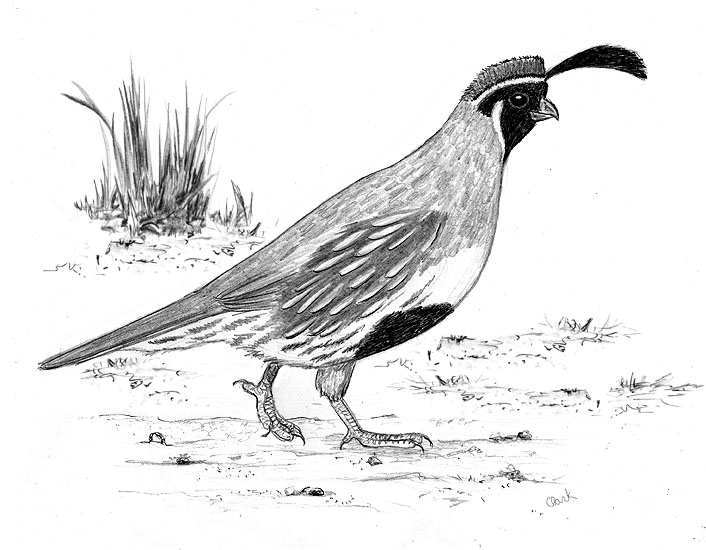
Dear Bird Folks,
The bird in the attached photo has been coming to my friend’s yard for the last few days, but it’s not in any of my Cape Cod bird books. Any idea what it is?
– Bruce, Brewster, MA
Not Brewster again, Bruce,
I don’t know what is going on in your town, but between hearing about peacocks, white turkeys, something called a “Tennessee Red Quail” and now this unusual bird, I’m beginning to think Brewster is evolving its own ecosystem. Where are all these oddballs coming from, you ask? Good question. Maybe they’re old high school buddies in the middle of a summer road trip. They could also be escapees from someone’s backyard coop, but I like the buddy road trip story better.
Your mystery bird is a Gambel’s Quail, a bird normally found in the desert Southwest. It looks very much like the more widely known California Quail, with both birds having the classic quail-style head plume (which is actually several feathers joining together to look like one). As is the case with most quail, Gambel’s Quail are highly gregarious, traveling about in large coveys. The birds tend to be most active early in the morning (before the desert gets too hot) and later in the afternoon (when it cools down). They are mostly vegetarians, but will occasionally slip up and eat few insects, especially during the breeding season. Mesquite is one of their favorite plants, as the birds readily consume both the blossoms and the leaves. They also eat mesquite seeds, but only after other creatures have eaten them first. Apparently, mesquite pods are too tough for the birds, so they wait for the seeds to pass through some large mammal (i.e., cow) first, before picking them out of the mammal’s poop. Ah, the joys of being a vegetarian.
The Gambel’s Quail was named after William Gambel, a young naturalist from Philadelphia, who, at the ripe old age of eighteen, left PA to explore and catalog the plants and animals of the Southwest. A few years later Bill returned to Philly, went to medical school and became a doctor. Somewhere along the way, he also changed the spelling of his name from Gamble to Gambel, for no apparent reason except to be hip. Upon hearing of California’s Gold Rush and the need for doctors, Gambel once again headed west. His first (and only) stop was at a gold mining town that happened to be in the midst of a typhoid outbreak. He tried to help the miners, but contracted the disease himself and eventually died from it at the not-so-ripe old age of twenty-six. Out of appreciation for his work, the residents in the town buried young Gambel beneath a giant ponderosa pine. This was a nice gesture, but the big tree, along with the grave, were subsequently washed away by hydraulic mining. Oh well, it’s the thought that counts.
Here in the United States, the law prohibits us from keeping our native birds as pets. This is why you aren’t likely to walk into your aunt’s house and see a cardinal sitting on her shoulder. There are, however, exceptions for game birds for some reason. Quail, for example, are all available for purchase online. Massachusetts requires a permit for keeping these birds; whether anyone actually obtains such a permit is another question.
Gambel’s Quail are basically a sedentary species, Bruce. They don’t usually wander very far from “home.” Plus, they aren’t strong flyers. Therefore, it doesn’t seem likely that one lone bird would make the 2,700-mile journey from Arizona, on foot, just to visit the town of Brewster. (No offense.) The evidence suggests that somebody in your town is raising unusual birds, and is doing a poor job of keeping track of them. BTW: Remember the Tennessee Red Quail I mentioned earlier? Don’t bother looking that up in your book either. It won’t be there. The Tennessee Red Quail is not a species; it’s a mutant, but not the cool kind of mutant like Wolverine or Storm. It’s just a messed up bobwhite that some people raise on purpose. That’s all I’m going to say about it. Breeding designer birds creeps me out.
Now for the elephant:
We’ve been receiving a lot of questions about a mysterious illness that has been affecting birds in the Mid-West and Mid-Atlantic states. As of this writing, the problem has not spread into our area. (Phew!) Very little is known about it, except young grackles, robins, jays and starlings appear to be the most often affected. Symptoms include loss of coordination and crusted eyes. This illness should not be confused with the decades-old House Finch eye disease, although the symptoms appear similar. What can we do to keep our birds safe? As always, we need to keep our feeders and birdbaths clean, as well as the area around them. Should we stop feeding birds? Right now, the answer is yes. Mass Audubon just posted that we should give our feeders and birdbaths a good cleaning and “out of an abundance of caution” not put them back out for week or so, until more is known about this illness. At this point, there is no evidence that the ailment is contracted at feeders or that it’s even in our area, but it also doesn’t hurt to be extra careful until we know more. I’m sure some people will be upset by this news, but how do you think I feel? After a yearlong shutdown, I can finally fully open my shop again and now this. And just when I was able to afford groceries once more. Oh, don’t worry about me. I’ll be fine. Suddenly I have a lot of extra birdseed to eat.